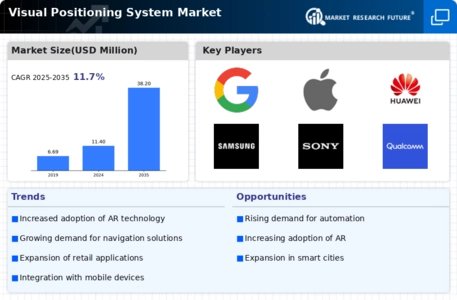-
EXECUTIVE SUMMARY
-
Market Attractiveness Analysis
-
Global Visual Positioning System Market, by Component
-
Global Visual Positioning
-
System Market, by Location
-
by Type
-
Global Visual Positioning System Market,
-
Global Visual Positioning System Market, by Solution
-
Global
-
Visual Positioning System Market, by Platform
-
Global Visual Positioning
-
System Market, by Application
-
by Region
-
Global Visual Positioning System Market,
-
MARKET INTRODUCTION
-
Definition
-
Scope of the Study
-
Market Structure
-
Key Buying Criteria
-
Macro Factor Indicator Analysis
-
RESEARCH METHODOLOGY
-
Research Process
-
Primary Research
-
Secondary Research
-
Market Size Estimation
-
Forecast Model
-
List of Assumptions
-
MARKET DYNAMICS
-
Introduction
-
Drivers
- Rising
- Increasing
- Drivers Impact Analysis
-
demand for artificial intelligence (AI)-enabled optical sensors
-
use of commercial drones for security and law enforcement as well as agricultural
-
purposes around the world
-
Restraints
- Need for a secure and dependable
- Restraints Impact Analysis
-
Expensive installation and maintenance costs
-
communication infrastructure
-
Opportunities
-
VPS can be used for power AR applications, which can overlay digital information
-
on top of the real world
-
Challenges
- Implementing government
- Competition Among Regional Players
-
rules on drone use
-
Impact
- Impact on Visual Positioning System Providers
-
of COVID-19
-
Impact on the End Use
-
MARKET FACTOR ANALYSIS
-
Value Chain Analysis/Supply
-
Chain Analysis
-
Porter’s Five Forces Model
-
Bargaining Power of Suppliers
-
Bargaining Power of Buyers
-
Threat of New Entrants
-
Threat of Substitutes
-
Intensity of Rivalry
-
GLOBAL VISUAL POSITIONING SYSTEM MARKET, BY COMPONENT
-
Introduction
-
Sensors
-
Camera Systems
-
Markers
-
Others
-
GLOBAL VISUAL POSITIONING SYSTEM MARKET, BY LOCATION
-
Introduction
-
Indoor
-
Positioning System
-
Outdoor Positioning System
-
GLOBAL VISUAL POSITIONING SYSTEM
-
MARKET, BY TYPE
-
Introduction
-
1D
-
2D
-
3D
-
GLOBAL VISUAL POSITIONING SYSTEM
-
MARKET, BY SOLUTION
-
Introduction
-
Navigation
-
Analytics
-
Tracking
-
Industrial Solutions
-
Others
-
GLOBAL VISUAL POSITIONING SYSTEM MARKET, BY
-
PLATFORM
-
Introduction
-
UAVs/Drones
-
AGV
-
Robotics
-
AUV
-
Others
-
GLOBAL VISUAL POSITIONING SYSTEM MARKET, BY APPLICATION
-
Introduction
- Retail
- Healthcare
- Industrial
- Hospitality
- Others
-
Commercial Application
-
Transportation & Logistics
-
Defense
-
Application
-
GLOBAL VISUAL POSITIONING SYSTEM MARKET SIZE ESTIMATION
-
& FORECAST, BY REGION
-
Introduction
-
North America
-
Market Estimates & Forecast, by Country, 2019-2032
-
Forecast, by Component, 2019-2032
-
Estimates & Forecast, by Solution, 2019-2032
-
Forecast, by Platform, 2019-2032
-
Market Estimates &
-
Market Estimates & Forecast, by Location,
-
Market Estimates & Forecast, by Type, 2019-2032
-
Market
-
Market Estimates &
-
Market Estimates & Forecast, by Application,
-
US
-
Market Estimates & Forecast, by Component, 2019-2032
-
Market Estimates & Forecast, by Location, 2019-2032
-
Forecast, by Type, 2019-2032
-
Market Estimates &
-
Market Estimates & Forecast, by Solution,
-
Market Estimates & Forecast, by Platform, 2019-2032
-
Market Estimates & Forecast, by Application, 2019-2032
-
Canada
-
Market Estimates & Forecast, by Component, 2019-2032
-
Forecast, by Location, 2019-2032
-
Market Estimates &
-
Market Estimates & Forecast, by Type,
-
Market Estimates & Forecast, by Solution, 2019-2032
-
Market Estimates & Forecast, by Platform, 2019-2032
-
Forecast, by Application, 2019-2032
-
Forecast, by Component, 2019-2032
-
Market Estimates &
-
Mexico
-
Market Estimates &
-
Market Estimates & Forecast, by Location,
-
Market Estimates & Forecast, by Type, 2019-2032
-
Market Estimates & Forecast, by Solution, 2019-2032
-
Forecast, by Platform, 2019-2032
-
Market Estimates &
-
Market Estimates & Forecast, by Application,
-
Europe
- Market Estimates & Forecast, by Country, 2019-2032
-
Market Estimates & Forecast, by Component, 2019-2032
-
Forecast, by Location, 2019-2032
-
Market Estimates &
-
Market Estimates & Forecast, by Type,
-
Market Estimates & Forecast, by Solution, 2019-2032
-
Market Estimates & Forecast, by Platform, 2019-2032
-
Forecast, by Application, 2019-2032
-
Forecast, by Component, 2019-2032
-
Market Estimates &
-
UK
-
Market Estimates &
-
Market Estimates & Forecast, by Location,
-
Market Estimates & Forecast, by Type, 2019-2032
-
Market Estimates & Forecast, by Solution, 2019-2032
-
Forecast, by Platform, 2019-2032
-
Market Estimates &
-
Market Estimates & Forecast, by Application,
-
Germany
-
Market Estimates & Forecast, by Component,
-
Market Estimates & Forecast, by Location, 2019-2032
-
Market Estimates & Forecast, by Type, 2019-2032
-
Forecast, by Solution, 2019-2032
-
France
-
Market Estimates &
-
Market Estimates & Forecast, by Platform,
-
Market Estimates & Forecast, by Application, 2019-2032
-
Market Estimates & Forecast, by Component, 2019-2032
-
Market Estimates & Forecast, by Location, 2019-2032
-
Forecast, by Type, 2019-2032
-
Market Estimates &
-
Market Estimates & Forecast, by Solution,
-
Market Estimates & Forecast, by Platform, 2019-2032
-
Market Estimates & Forecast, by Application, 2019-2032
-
Rest of Europe
-
Market Estimates & Forecast, by Component, 2019-2032
-
Forecast, by Location, 2019-2032
-
Market Estimates &
-
Market Estimates & Forecast, by Type,
-
Market Estimates & Forecast, by Solution, 2019-2032
-
Market Estimates & Forecast, by Platform, 2019-2032
-
Forecast, by Application, 2019-2032
-
Estimates & Forecast, by Country, 2019-2032
-
Forecast, by Component, 2019-2032
-
Estimates & Forecast, by Solution, 2019-2032
-
Forecast, by Platform, 2019-2032
-
Market Estimates &
-
Asia-Pacific
- Market
- Market Estimates &
- Market Estimates & Forecast, by Location,
- Market Estimates & Forecast, by Type, 2019-2032
- Market
- Market Estimates &
- Market Estimates & Forecast, by Application,
- China
-
Market Estimates & Forecast, by Location, 2019-2032
-
Forecast, by Type, 2019-2032
-
Market Estimates &
-
Market Estimates & Forecast, by Solution,
-
Market Estimates & Forecast, by Platform, 2019-2032
-
Market Estimates & Forecast, by Application, 2019-2032
-
Japan
-
Market Estimates & Forecast, by Component, 2019-2032
-
Forecast, by Location, 2019-2032
-
Market Estimates &
-
Market Estimates & Forecast, by Type,
-
Market Estimates & Forecast, by Solution, 2019-2032
-
Market Estimates & Forecast, by Platform, 2019-2032
-
Forecast, by Application, 2019-2032
-
Forecast, by Component, 2019-2032
-
Market Estimates &
-
India
-
Market Estimates &
-
Market Estimates & Forecast, by Location,
-
Market Estimates & Forecast, by Type, 2019-2032
-
Market Estimates & Forecast, by Solution, 2019-2032
-
Forecast, by Platform, 2019-2032
-
by Component, 2019-2032
-
Market Estimates &
-
Market Estimates & Forecast, by Application,
-
Rest of Asia-Pacific
-
Market Estimates & Forecast,
-
Market Estimates & Forecast, by Location,
-
Market Estimates & Forecast, by Type, 2019-2032
-
Market Estimates & Forecast, by Solution, 2019-2032
-
Forecast, by Platform, 2019-2032
-
Market Estimates &
-
Market Estimates & Forecast, by Application,
-
Rest of the World
- Middle East & Africa
-
Market Estimates & Forecast, by Component, 2019-2032
-
Forecast, by Location, 2019-2032
-
Market Estimates &
-
Market Estimates & Forecast, by Type,
-
Market Estimates & Forecast, by Solution, 2019-2032
-
Market Estimates & Forecast, by Platform, 2019-2032
-
Forecast, by Application, 2019-2032
-
Market Estimates &
-
South America
-
Market Estimates & Forecast, by Component, 2019-2032
-
Forecast, by Location, 2019-2032
-
Market Estimates &
-
Market Estimates & Forecast, by Type,
-
Market Estimates & Forecast, by Solution, 2019-2032
-
Market Estimates & Forecast, by Platform, 2019-2032
-
Forecast, by Application, 2019-2032
-
Market Estimates &
-
COMPETITIVE LANDSCAPE
-
Introduction
-
Key Developments & Growth Strategies
-
Competitor Benchmarking
-
Vendor Share Analysis, 2022 (% Share)
-
COMPANY PROFILES
-
Google
-
Apple
-
Huawei
-
Samsung
-
Sony
-
Qualcomm
-
MediaTek
-
Infineon
-
STMicroelectronics
-
Broadcom
-
Texas Instruments
-
NXP Semiconductors
-
Infineon Technologies
-
Epson
-
Zebra
- Company Overview
- Financial Overview
- Key Developments
- SWOT Analysis
-
Technologies
-
Solution/Services Offered
-
Key Strategies
-
NOTE:
-
This table of content is tentative and subject to
-
change as the research progresses.
-
In section 14, only the top 15 companies
-
will be profiled. Each company will be profiled based on the Market Overview, Financials,
-
Service Portfolio, Business Strategies, and Recent Developments parameters.
-
-
The companies are selected based on two broad criteria¬– strength of product
-
portfolio and excellence in business strategies.
-
Key parameters considered for
-
evaluating strength of the vendor’s product portfolio are industry experience,
-
product capabilities/features, innovations/R&D investment, flexibility to customize
-
the product, ability to integrate with other Platforms, pre- and post-sale services,
-
and customer ratings/feedback.
-
Key parameters considered for evaluating a vendor’s
-
excellence in business strategy are its market share, global presence, customer
-
base, partner ecoPlatform (technology alliances/resellers/distributors), acquisitions,
-
and marketing strategies/investments.
-
The financial details of the company
-
cannot be provided if the information is not available in the public domain and
-
or from reliable sources.

















Leave a Comment